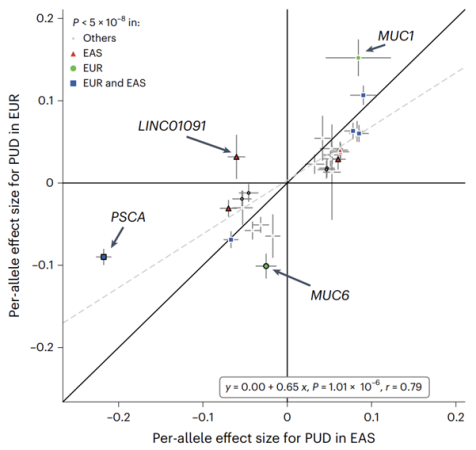Researchers studied stomach and duodenal ulcers in a large research project comparing Japanese and European populations. They found 25 new genetic markers linked to ulcers which showed that, though these sores on the walls of the stomach and of the duodenum (the beginning part of the small intestine) share some genetic factors, stomach ulcers have more possible causes. The study also identified a genetic link related to a bacterium called Helicobacter pylori. The research suggests that the differentiation of stomach cells and the regulation of hormones play a crucial role in the development of ulcers.
Peptic ulcers, caused by the erosion of the lining of the lower esophagus, stomach or upper small intestine, affect around 8 million people each year and have a variety of unpleasant gastrointestinal symptoms, some of which can be fatal in extreme circumstances. Naturally, there is a lot of research on this disease; however, up until now, most large-scale studies have focused on European populations, but it’s thought that genetic variation between populations around the world may play a factor in how the disease manifests, as there are different varieties and conditions which vary among regions. For example, in Japan, stomach ulcers are more common than duodenal ones, whereas in Europe, it’s the reverse.
“We performed a large-scale genome study of more than 50,000 peptic ulcer patients and 900,000 controls, or unafflicted people, of East Asian or European ancestries,” said Professor Yoichiro Kamatani from the Department of Computational Biology and Medical Sciences at the University of Tokyo. “This study combined multiple previous studies, and by doing so, we’ve been able to successfully identify 25 areas on the genome now known to be associated with peptic ulcers. Identifying such sites is a pivotal step in the search for new treatments.”
Kamatani and his team also explored a link between Helicobacter pylori (HP) and confirmed the bacteria can infect a host carrying certain genes discovered in this study, with peptic ulcer disease. This particular infection is also more prevalent in East Asian populations than in European populations. However, given the 25 newly identified genetic markers for ulcer susceptibility are common to both European and Asian populations, the team thought the reason for the geographic variation must lie beyond the genes.
“Building upon our previous studies looking at other factors surrounding peptic ulcers, we concluded that the way gastrointestinal cells differentiate from one another during gastric repair and the way gastrointestinal hormones are regulated play a critical role in the formation of peptic ulcers,” said Kamatani. “This knowledge may help provide specific targets for new drugs to reduce symptoms, and the genetic analysis could improve the way medical practitioners rate risks for peptic ulcers, even at the individual level.”
Some of this research proved difficult until recently, partly due to the huge data sets required and the ability to perform analyses on them, but also as it’s only now that the genetic sequencing of single cells from the human stomach and duodenum can occur at scale. The team hopes this kind of large-scale cross-population study can open up more possibilities to explore the way different diseases can affect different populations in different ways.
“Prioritizing ancestry diversity in studies of not only peptic ulcers, but also other complex traits, is critical to understanding the genetic factors at play in a more comprehensive and unbiased manner,” said Kamatani. “This serves as the foundation for translation into clinical interventions that can reduce suffering for millions of people around the world.”

Population variation
This chart shows how there are some outlying instances of different populations with different predominant types of peptic ulcers amongst sufferers. ©2023 Kamatani et al.
Journal article
Yunye He, Masaru Koido, Yoichi Sutoh, Mingyang Shi, Yayoi Otsuka-Yamasaki, Hans Markus Munter, BioBank Japan, Takayuki Morisaki, Akiko Nagai, Yoshinori Murakami, Chizu Tanikawa, Tsuyoshi Hachiya, Koichi Matsuda, Atsushi Shimizu & Yoichiro Kamatani.
“East Asian-specific and cross-ancestry genome-wide meta-analyses provide mechanistic insights into peptic ulcer disease”,
Nature Genetics
https://doi.org/10.1038/s41588-023-01569-7
“East Asian-specific and cross-ancestry genome-wide meta-analyses provide mechanistic insights into peptic ulcer disease”,
Nature Genetics
https://doi.org/10.1038/s41588-023-01569-7
Funding
This research was supported by the Ministry of Education, Culture, Sports, Sciences and Technology (MEXT) of the Japanese government and the Japan Agency for Medical Research and Development (AMED) under grant nos. JP18km0605001/JP23tm0624002 (the BioBank Japan project), JP19km0405215 (to C.T., K.M. and Y.K.), JP22zf0127009 (to K.M.) and JP223fa627011 (to K.M. and Y.K.). This work was supported by the Tohoku Medical Megabank Project (Special Account for the Reconstruction of the Great East Japan Earthquake) from MEXT and AMED (grant nos. JP15km0105004 and JP21tm0124006), including the supercomputer resource powered by the AMED research grant (no. JP20km0405001).Research contact
Professor Yoichiro KamataniLaboratory of Complex Trait Genomics, Graduate School of Frontier Sciences
The University of Tokyo
https://www.u-tokyo.ac.jp/focus/en/people/k0001_02844.html
Department of Computational Biology and Medical Sciences
https://www.cbms.k.u-tokyo.ac.jp/english/index.html
Graduate School of Frontier Sciences
https://www.k.u-tokyo.ac.jp/en/index.html
Press contact
Mr. Rohan MehraPublic Relations Group, The University of Tokyo
https://www.u-tokyo.ac.jp/en/index.html
About The University of Tokyo
The University of Tokyo is Japan's leading university and one of the world's top research universities. The vast research output of some 6,000 researchers is published in the world's top journals across the arts and sciences. Our vibrant student body of around 15,000 undergraduate and 15,000 graduate students includes over 4,000 international students. Find out more at www.u-tokyo.ac.jp/en/ ointestr follow us on Twitter at @UTokyo_News_en.UTokyoFOCUS PRESS RELEASES
https://www.u-tokyo.ac.jp/focus/en/press/z0508_00321.html
